- In 2022 a major report from the National Academies of Sciences, Engineering, and Medicine warned that enormous wind turbines severely affect the marine vessel radar (MVR) used for navigating waterways shared by commercial and recreational vessels as well as extremely large commercial shipping vessels
- Disrupted radar systems can result in deadly open-seas collisions — and they can also hinder search and rescue operations
- In April the U.S. Coast Guard warned mariners of the dangers of bulk ships carrying oversized wind turbine parts obscuring visibility from their navigational bridges
In recent weeks the U.S. Coast Guard and commercial and recreational fishing vessels as well as commercial shippers have been alerted to serious problems for maritime safety posed by gigantic offshore wind turbines and even their construction.
Marine vessel radar cluttered with “significant electromagnetic reflectivity”
As mentioned in the previous research brief, in February 2022 a major report from the National Academies of Sciences, Engineering, and Medicine warned of significant radar disruption from offshore wind turbines. The report found that marine vessel radar (MVR) are severely affected by the presence of wind turbines.
Why that finding is ominous is that MVR is commonly used for traversing waterways. Not every day at sea is a calm and clear (or, of course, even day). The waterways are used not only by commercial and recreational vessels, but also by extremely large commercial shipping vessels — as well as search and rescue vessels.
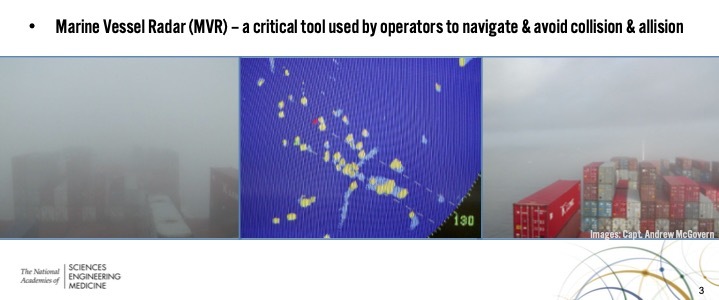
Source: National Academics of Sciences, Engineering, and Medicine briefing, February 22, 2022
Being large steel structures, offshore wind turbines have “significant electromagnetic reflectivity and the capacity to interfere with radar systems in their vicinity.”
The report from the National Academies of Sciences, Engineering, and Medicine found that offshore wind turbines — these “large structures predominantly constructed of steel” — have “significant electromagnetic reflectivity and the capacity to interfere with radar systems in their vicinity.”
Wind turbine generators’ impacts to marine vessel radar
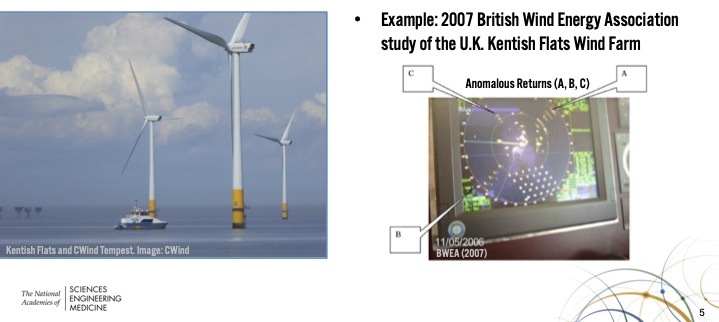
(Note: The Kentish Flats Wind Farm features turbines much smaller than those planned offshore the beaches of North Carolina — 377 feet tall vs. 853 to 1,042 feet tall)
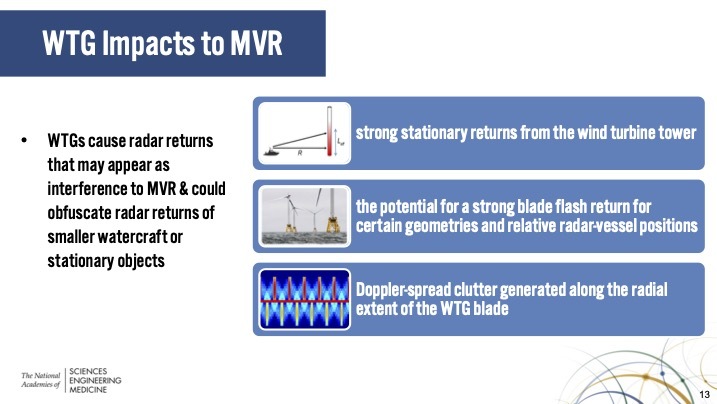
Source: National Academics of Sciences, Engineering, and Medicine briefing
As a reminder: the wind energy areas planned off the coast of Brunswick County beaches would feature large numbers of these turbines that, at 853 feet tall, would rival the tallest building in the state. Meanwhile, the wind energy area planned off the Outer Banks would feature 69 turbines of 1,042 feet tall apiece — 20 percent taller than the tallest manmade structure in the state.
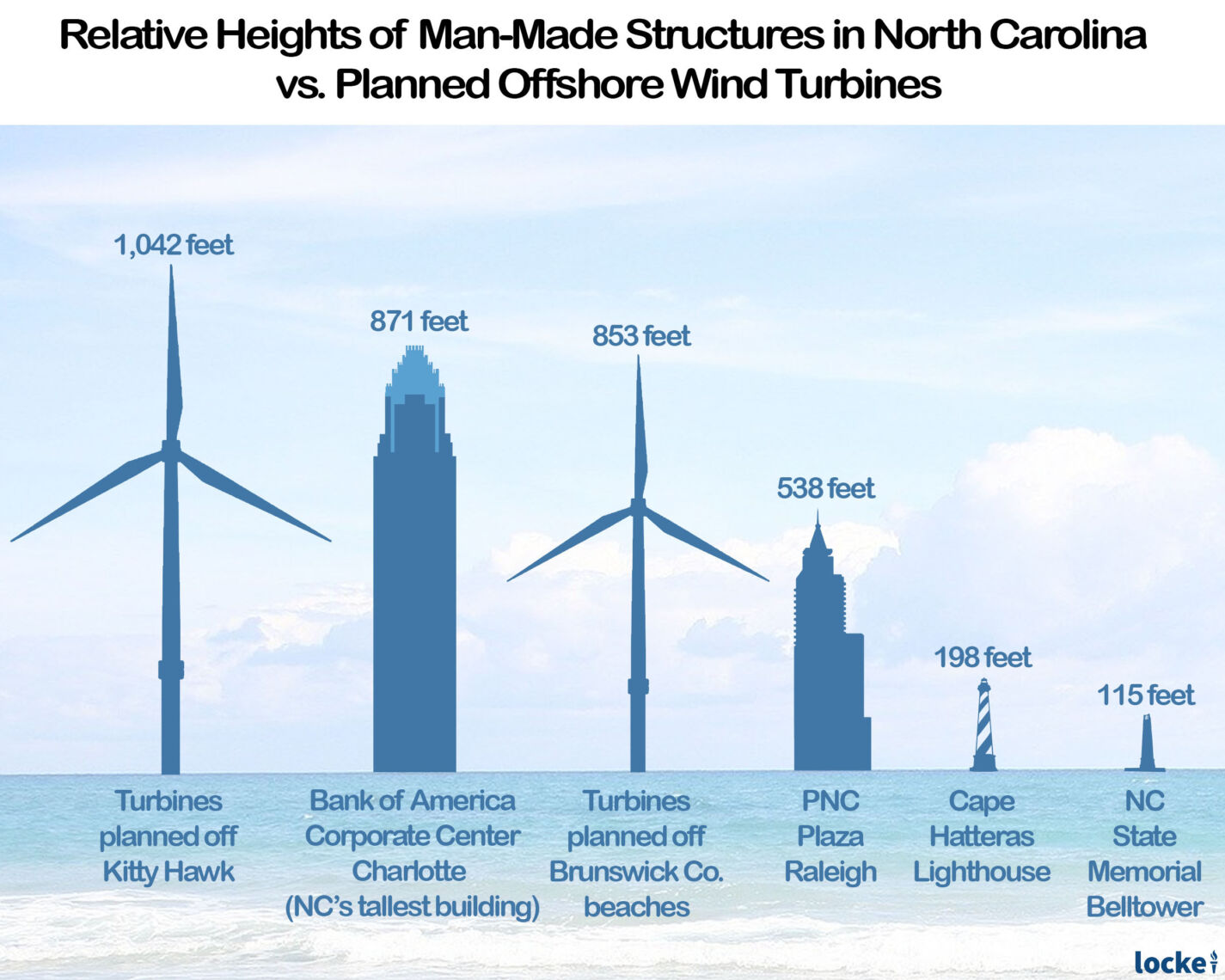
The report found that the turbines cause “a substantial increase in strong, reflected energy cluttering the operator’s display, leading to complications in navigation decision-making.” Making things worse, when the winds are blowing, the wind towers are even more disruptive. The report explained, “The rotating blades can also create reflections in Doppler radar systems.”
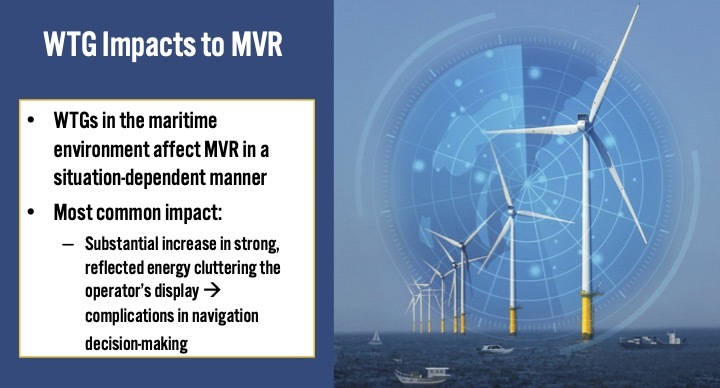
Source: National Academics of Sciences, Engineering, and Medicine briefing
For those thinking that the problem would be easy to fix, the report found otherwise. While the report offered some ways for mitigation, it noted that there is “no simple modification” that could allow marine vessel radar to operate in “the complex environments of a fully populated continental shelf wind farm.”
Deadly open-seas collisions and hampered search and rescue efforts
Disrupted radar systems are not mere hassles of dealing with cluttered displays. They can result in deadly open-seas collisions. The turbines can “cast radar shadows, obfuscating smaller vessels exiting wind facilities in the vicinity of deep draft vessels in Traffic Separation Schemes.”
Disrupted radar systems can result in deadly open-seas collisions — and then interfere with search and rescue efforts.
Should collisions or other emergencies happen, the turbines make it harder to save lives. As the report noted, “Maritime search and rescue (SAR) assets rely on MVR to search for smaller boats as their primary targets in the conduct of ordinary SAR operations. A loss of contact with smaller vessels due to various forms of MVR interference could complicate MTS [Maritime Transportation System] operations, and is therefore particularly consequential when conducting maritime surface SAR operations in and adjacent to an offshore wind farm.”
In other words, maritime search and rescue efforts also rely on MVR. If MVR interference from offshore wind turbines compromise their operations, they could lose touch with their targets, which could result in unnecessary loss of life.
Huge wind turbine parts obscuring bulk carriers’ navigational visibility
Mariners face new dangers even before the turbines get built, however. On April 4, the Coast Guard had to issue a safety warning to mariners alerting them to the dangers of bulk carriers being given special exemptions from internationally recognized safety standards of visibility from the navigation bridge.
The ships are being given special dispensations to let them bring in wind turbine parts, especially blades. The problem is that the parts are so large that they severely limit visibility from the navigation bridge. The Coast Guard warns that they are “stowed in a manner that substantially limits visibility from the navigation bridge.”
Coast Guard image of “substantially limit[ed] visibility” from the navigation bridge owing to how excessively large wind turbine parts are stowed
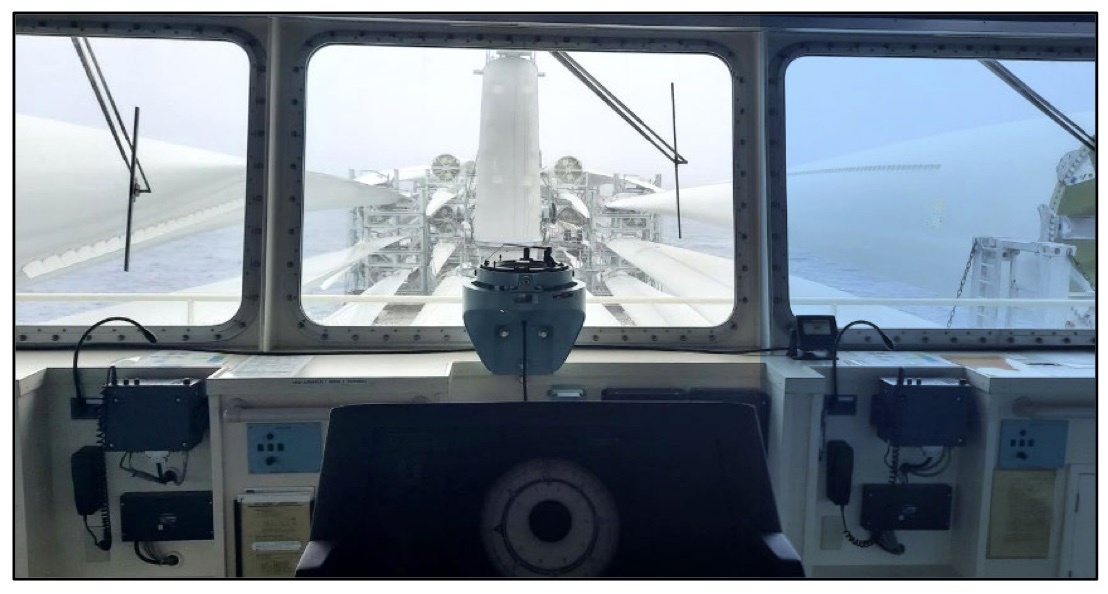
Source: U.S. Coast Guard
The Coast Guard warned mariners to be on the lookout for these bulk carriers with large, dangerous blind spots, especially in congested areas and narrow channels. The letter noted, “In some cases, flag administrations have issued dispensations of SOLAS V/22, despite the vessel’s intended voyage requiring substantial transit within restricted navigational channels and confined inland waterways with congested maritime traffic.”
The Coast Guard then warned operators of bulk carriers not to think that a dispensation letter was a free pass for dangerous navigation. “Dispensation letters issued by flag administrations or recognized organizations do not exempt vessels from complying with corresponding U.S. requirements on navigation bridge visibility found in Title 33 Code of Federal Regulations (CFR) § 164.15,” the bulletin warned. Furthermore, “The U.S. Coast Guard does not typically grant deviations for situations intentionally counter to the regulations or solely for convenience or financial incentive.”
More consequences of heedlessly seeking political “wins”
Pres. Joe Biden and his administration, aided by ideological allies such as North Carolina Gov. Roy Cooper, continue to rush a political goal for building offshore wind facilities without regard to consequences. They do so in deliberate and irresponsible ignorance of the long-term and even short-term effects on electricity costs, unreliability issues given an intermittent energy source that fully depends on the whims of Nature to produce electricity, exacerbation of energy poverty, inability to yield any measurable or palpable difference in climate change, harms to critically endangered, threatened, and other marine animals and avian species, negative impacts on job creation and economic growth, ill effects it will have on the coastal fishing industry and beach tourism, compromised national defense and interference with military training and operations, questionable ability to withstand storms in North Carolina’s uniquely hurricane-prone waters, and serious problems with disposing of “forever waste” from blades.
Disrupting maritime radar, endangering mariners, and risking open-seas collisions from radar problems and hindered visibility are just more unfortunate consequences of choosing political “wins” over prudent policy.


